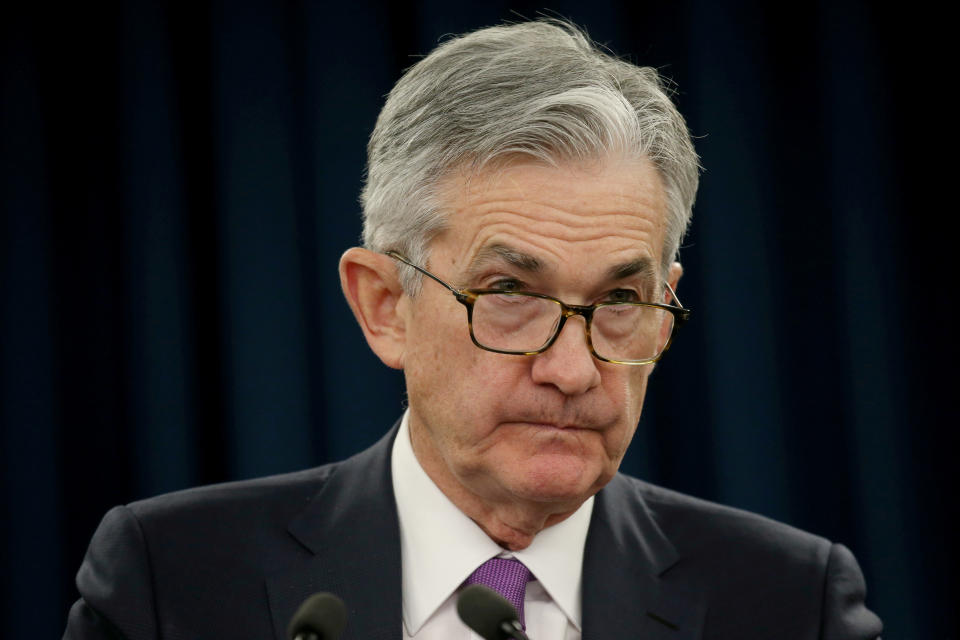Fed commits to near-zero rates as US economy sees 'sharp declines'
The Federal Reserve said Wednesday that it will keep interest rates at near-zero until the policymakers are “confident that the economy has weathered recent events.”
In its Federal Open Market Committee statement, the Fed said the U.S. economy has seen “sharp declines” in economic activity as millions of Americans lose their jobs. The Fed also flagged weaker demand and “significantly lower” oil prices as factors holding down consumer activity.
“The disruptions to economic activity here and abroad have significantly affected financial conditions and have impaired the flow of credit to U.S. households and businesses,” the Fed said.
In the meantime, the Fed said the public health crisis will continue to “weigh heavily” on the U.S. economy, employment, and inflation in the near term and poses “considerable risks” to the outlook over the medium term.

The decision keeps interest rates in a target range of 0% to 0.25%, maintaining the interest that it pays on required and excess reserves at 10 basis points.
The Fed also committed to purchasing Treasury securities and agency residential and commercial mortgage-backed securities “in the amounts needed to support smooth market functioning.” The statement said the FOMC could “adjust its plans as appropriate.”
The policy decision was unanimously agreed upon and comes after nearly two months of emergency moves as the Fed continues to fight the economic consequences of a near-nationwide stoppage on business activity amid the COVID-19 crisis.
Emergency actions
On March 3, the Fed cut interest rates by 50 basis points. But as the number of U.S. coronavirus cases exploded, the Fed decided it could not wait until its pre-scheduled March 18 meeting to move further. It made an emergency Sunday night announcement slashing interest rates to near-zero and restarting its crisis-era policy of asset purchases through quantitative easing.
But the Fed was far from done.
In the weeks following, the central bank unveiled nine facilities aimed at addressing liquidity in markets ranging from U.S. dollars to risky corporate debt. Not all of those facilities are open yet, and questions continue to swirl over the forthcoming Main Street Lending Program, which hopes to offer cheap four-year loans to medium-sized businesses with up to 10,000 employees.
Policymakers have been updating the terms of its facilities about as often as they have been unveiling new ones, and its most recent revision addressed its Municipal Lending Facility.
On Monday, the Fed expanded the scope of its direct muni bond purchases to cover more cities and counties, citing the need to “help manage cash flow stresses” that states and municipalities face in the form of budget shortfalls.
Fed officials have been clear that the central bank can do more, if needed.
The last time Powell spoke publicly, on April 9, he committed the Fed to using its powers “forcefully, proactively, and aggressively” until the economy looks poised for recovery.
Brian Cheung is a reporter covering the Fed, economics, and banking for Yahoo Finance. You can follow him on Twitter @bcheungz.
Cafe chain Cosi sues SBA for excluding bankrupt companies from emergency loans
FOMC Preview: Powell to face 'status check' on Fed's emergency actions
Fed extends municipal liquidity facility beyond largest cities
Fed considers throwing universities a lifeline as furloughs begin
A glossary of the Federal Reserve's full arsenal of 'bazookas'
Read the latest financial and business news from Yahoo Finance
Follow Yahoo Finance on Twitter, Facebook, Instagram, Flipboard, SmartNews, LinkedIn, YouTube, and reddit.
